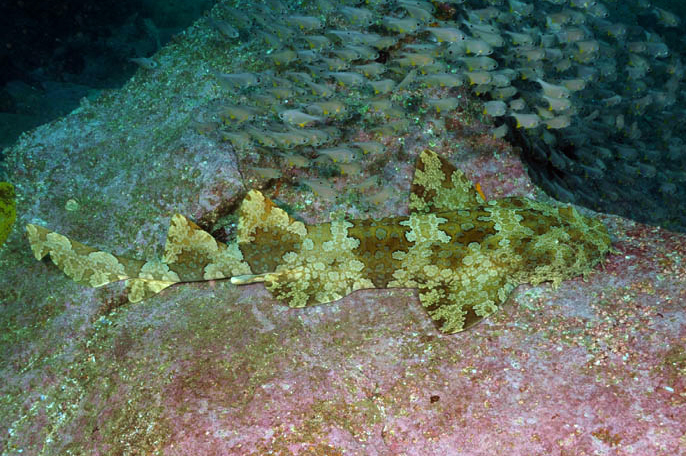Gulf Wobbegong, Orectolobus halei Whitley 1940
Other Names: Banded Carpet Shark, Banded Wobbegong, Carpetshark, Gulf Wobbegong, Wobbegong

A Gulf Wobbegong, Orectolobus halei. Source: Dave Harasti / http://www.daveharasti.com/. License: All rights reserved
Summary:
A large brownish wobbegong with well-defined black-edged saddles containing paler markings that lack whitish rings and blotches.
Video of a Gulf Wobbegong in Jervis Bay, New South Wales, 2013.
Video of a Gulf Wobbegong in Jervis Bay, New South Wales, 2013.
Cite this page as:
Bray, D.J. 2019, Orectolobus halei in Fishes of Australia, accessed 03 Jul 2025, https://fishesofaustralia.net.au/Home/species/3268
Gulf Wobbegong, Orectolobus halei Whitley 1940
More Info
|
Distribution |
Endemic to the southern half of Australia from Hervey Bay, Queensland, south to off Flinders Island, Bass Strait, Tasmania, and west to Norwegian Bay, Western Australia. Inhabits bays, macroalgal-covered reefs, coral reef lagoons, reef flats, reef faces and reef channels, and around offshore islands. This nocturnal species rests in caves, under ledges, in trenches, and on large sponges during the day. |
|
Biology |
Males mature at 1684-1819 mm TL, females mature at 1605-1871 mm TL. Females give birth to large litters (17-47 pups) in Spring, following a gestation period of about 10–11 months. |
|
Fisheries |
Taken in commercial and recreational fisheries as a target species and as bycatch. Historically, the skin was used as decorative leather. |
|
Remarks |
Orectolobus halei was previously synonymised thought to be the adult form of Orectolobus ornatus. |
|
Similar Species |
The Gulf Wobbegong, Orectolobus halei, differs from the Banded Wobbegong, Orectolobus ornatus, in having black edges around the saddles and fewer freckles, larger adult size (greater than 120 cm TL), more dermal lobes at the posterior preorbital group (4–6), precaudal vertebrae count (>106), spiral valve count (>25), and two supraorbital knobs. O. halei also has a shorter pelvic fin to anal fin interspace, larger pectoral fins, larger head dimensions, and relatively larger claspers in mature males. O. halei differs from the Spotted Wobbegong. O. maculatus, in having fewer (4-6) dermal lobes at the posterior preorbital group, and a distinctive brownish upper body with well-defined, darker brown saddles surrounded by black edges, saddles containing paler markings that lack whitish rings and blotches (unlike O. maculatus). |
|
Etymology |
The species is named halei in honour of Herbert M. Hale, a former director of the South Australian Museum. |
|
Species Citation |
Orectolobus ornatus halei Whitley 1940. The Fishes of Australia. Part 1:81, figs 70-71. Type locality: Gulf St Vincent, South Australia, the Hump, 3.3 nautical miles offshore between Garie Beach and Wollongong, New South Wales [34°14'S]. |
|
Author |
Bray, D.J. 2019 |
|
Resources |
Gulf Wobbegong, Orectolobus halei Whitley 1940
References
Compagno, L.J.V. 1984. FAO Species Catalogue. Sharks of the World. An annotated and illustrated catalogue of shark species known to date. Hexanchiformes to Lamniformes. FAO Fisheries Synopsis No. 125. Rome : FAO Vol. 4(1) pp. 1-249. (as Orectolobus ornatus in part)
Compagno, L.J.V. 2001. Sharks of the World. An annotated and illustrated catalogue of shark species known to date. Bullhead, mackerel and carpet sharks (Heterodontiformes, Lamniformes and Orectolobiformes). Rome : FAO, FAO Species Catalogue for Fisheries Purposes No. 1 Vol. 2 269 pp. (as Orectolobus ornatus in part)
Compagno, L.J.V., Dando, M. & Fowler, S. 2005. A Field Guide to the Sharks of the World. London : Collins 368 pp. (as Orectolobus ornatus in part)
Compagno, L.J.V. & Niem, V.H. 1998. Families Squatinidae, Heterodontidae, Parascylliidae, Brachaeluridae, Orectolobidae, Hemiscylliidae. pp. 1235-1259 in Carpenter, K.E. & Niem, V.H. (eds). The Living Marine Resources of the Western Central Pacific. FAO Species Identification Guide for Fisheries Purposes. Rome : FAO Vol. 2 687-1396 pp. (as Orectolobus ornatus in part)
Corrigan, S., Huveneers, C., Stow, A. & Beheregaray, L.B. 2015. A multi-locus comparative study of dispersal in three codistributed demersal sharks from eastern Australia. Canadian Journal of Fisheries and Aquatic Sciences. https://doi.org/10.1139/cjfas-2015-0085, open access
Huveneers, C. 2006. Redescription of two species of wobbegongs (Chondrichthyes: Orectolobidae) with elevation of Orectolobus halei Whitley 1940 to species level. Zootaxa 1284: 29 –51.
Huveneers, C. 2007. The Ecology and biology of wobbegong sharks (genus Orectolobus) in relation to the commercial fishery in New South Wales, Australia. PhD Thesis, Macquarie University.
Huveneers, C., Harcourt, R.G. & Otway, N.M. 2006. Observations of localised movements and residence times of wobbegong sharks (Orectolobus halei) at Fish Rock, NSW, Australia. Cybium 30(4): 103–111.
Huveneers, C., Otway, N.M., Gibbs, S.E. & Harcourt, R.G. 2007. Quantitative diet assessment of wobbegong sharks (genus Orectolobus) in New South Wales, Australia. Journal of Marine Science 64: 1272–1281.









